New Hampshire NASA EPSCoR
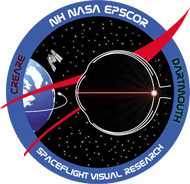 |
Research & Infrastructure Development
Ocular Changes in Space brings together a team with expertise in space physiology, opthalmology, and mathematical modeling. Their goal: to develop an integrated numerical model of ocular changes occurring under space flight conditions, aiding in understanding and diagnosing these problems.
Ocular changes occur in 50% of astronauts completing long duration International Space Station (ISS) missions and in 23% of astronauts completing short duration shuttle missions. The data suggests a relationship between length of stay in microgravity and changes in vision. One important missing piece
of information is the time course of a reported axial length reduction
(i.e., a reduced length of eye from cornea to retina) during extended space exposures.
(Read more on astronaut vision problems... )
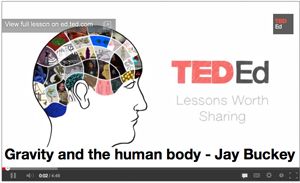 |
View a video on Gravity and the Human Body, presented by our NH NASA EPSCoR project P.I., Dr. Jay Buckey… |
Science lead of this investigation is Dartmouth Prof. of Medicine Jay Buckey, a former astronaut who flew on the biomedical Space Shuttle research mission Neurolab. Team members include Dr. Jacob Swan, environmental physiologist, and Dr. Michael Zegans, opthalmologist and Prof. of Surgery at Dartmouth Medical School. The study is a collaboration between Dartmouth College and Creare, Inc., a Hanover, NH, engineering research & development company.
Research goals:
GOAL 1: Develop a numerical model of the eye that accurately predicts changes to eye structure and function during postural change, estimating short- and long-term microgravity-induced changes.
GOAL 2:
Validate the numerical model using human data, comparing postures and human interventions. Validation will include data from the Flight Medicine program and a Longitudinal Study of Astronaut Health.
GOAL 3: Evaluate measurement technology that could be used on Intl. Space Station, providing additional modeling data.
Project Status (5/2014):
A numerical model is being built and validated, using data collected in 1-G, with both short- (~1min) and long-term (1 hour) changes in posture, as well as data from a short-term (~20 sec) microgravity exposure. The project has shown that in 1-G, short-term (~1min) changes in body posture affect intraocular pressure and axial length.
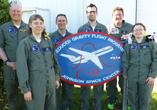 |
|
| Team photo prior to microgravity flight. | |
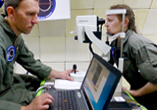 |
|
| Using optical coherence tomography to measure choroidal thickness during microgravity exposure |
In April 2014 the team traveled to Johnson Space Center to collect data aboard microgravity flights organized by the Reduced Gravity Office. In-flight exposures to brief microgravity (~15-25 seconds) allowed the team to monitor intraocular pressure, axial length, and choroid thickness. These data are used in modeling how the eye changes over time in microgravity.
Results indicate that changes in intraocular pressure seem to result from a loss of hydrostatic gradients upon entry into microgravity. Because hydrostatic gradients have been largely overlooked as a possible mechanism for microgravity-associated vision changes, the team will continue investigating hydrostatic gradients in the lab, and potentially on a 2015 return visit to Johnson Space Ctr.
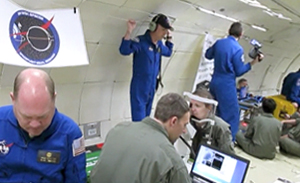 |
View a video taken during the microgravity flight (30 sec - m4v) |
